Art + Science = Moto's Perfect Marriage
CULINARY POINT OF VIEW
Richie's Recipe: Strawberries & Cream
In 2008, Chef Richie Farina showed up at the back door of Moto, resumé in hand, vying to work in the Michelin-starred Chicago restaurant. In January he was named Executive Chef. His goal since day one? To elevate the idea of molecular gastronomy by marrying traditional cooking techniques with the latest in scientific technology to showcase food in a way that harkens back to where it originated from. He uses his passion for science and art to reinforce the number one driver behind his dishes—the taste.
KELLY HENSEL: You started out making pizzas and helping your friend in the catering business. What about those two jobs led you to enroll in culinary school at Johnson and Wales University?
CHEF RICHIE FARINA: Well, initially I needed a job because I needed money, but once I got into it, I actually ended up really enjoying it. Then when I was doing a few catering gigs with my uncle’s friend, the chef that was running it told me about Johnson & Wales. I decided that I’d do something I wanted to pursue and it would satisfy my mom because I would have a degree as well. Johnson & Wales was the only one that was offering a four-year Bachelor’s degree, so that’s what kind of made me choose that school and take that path.
HENSEL: And then you came to Chicago in 2008 and just showed up at Moto’s back door. Now, you are the Executive Chef. Could you walk thru how that happens?
FARINA: Well, you see, my goal when I moved to Chicago was to pick a place where I wanted to call my home cooking wise. My initial goal was to stay there probably between four or five years. I wanted to be a sous chef by the fifth year.
Essentially, that happened within the first year and a half of me being at Moto. I was promoted unexpectedly. I was at a team meeting going through our normal daily stuff and at the end of the meeting, Homaro [owner Chef Homaro Cantu] announced that I was the Sous Chef. So I got thrown into the position there. I did that from 2009 through 2011.
And then in January of 2012, I took over as the Chef de Cuisine, pretty much running the day-to-day operations and planning all the food. I transferred the food to be my ideas, because before a lot of it was collaboration between me and Chris Jones, the old CDC. Essentially, it was my responsibility to come up with new dishes.
And then at the beginning of January, Homaro promoted me to Executive Chef. It was never my goal ever to get to this position, but just being challenged and pushed in that way, I guess I rose to the occasion and Homaro thought I could do it, so here I am now.
I’ve been working under Homaro for six years and it’s time now to develop my own brand so it’s exciting to have the opportunity to be the chef at a restaurant that allows me to do that.
HENSEL: Obviously, Chef Cantu has a very strong culinary point of view, and it kind of transcends Moto. It’s kind of his brand. How are you working at putting your own stamp on things, developing your own brand?
FARINA: My idea is to focus on making my brand or my style of food and knowing exactly what we’re trying to do now which is a good marriage of new technology while allowing old school techniques to shine through. I want to make a connection with where the food comes from, where it starts, and where it ends up.
HENSEL: For dishes at Moto, looks can be deceiving. You guys did an avocado dish where it looked like halved avocado but the skin was chocolate and the pit was tortilla chips. This approach can really throw off a diner’s perception. When constructing these dishes how much sensory science plays into the creation versus the taste?
FARINA: I think sensory science plays a good amount. If all the courses have the multi-sensory aspects, it can be overwhelming. Having a few here and there—maybe more aroma or more sight—kind of gives a reference point to go to. The avocado dish was essentially guacamole built like a taco, but the idea was to transform the way you would normally see guacamole. So one thing that I’ve learned over the years—Homaro calls it “transmodification”—so it’s pretty much taking recognizable flavors and presenting them in a way that you’re not used to seeing them. You know, like with the cigar we did. It was a Cuban pork sandwich, but it the form of a cigar.
For us to be able to change the appearance of how something is normally perceived the flavors need to be recognizable and the flavors have to be distinctive. So for diners to try something they think is weird looking, you have to taste it and instantly recognize what it is. If you taste it and don’t get or why it’s presented that way, then the thought behind the dish is lost.
Now, a lot of the stuff that I do is very nature based. I love to try to present things that either recall what they’re found on or where they came from. It’s about being able to make the connection between where it started and where you want to go with the idea.
For example, we had a river course on the menu for a while. It was a vase filled with river rocks and a little bit of wheat grass that looked like weeds and we had smoke in it. It featured all fish that were caught in rivers—trout, salmon. We were relating the original place where the food came from and translating it to the presentation vessel. So when we took the plastic wrap off the top, the smoke would pour out, which looked like water was running through the vase. Trying to make the connection, again, with what the concept of the dish is.
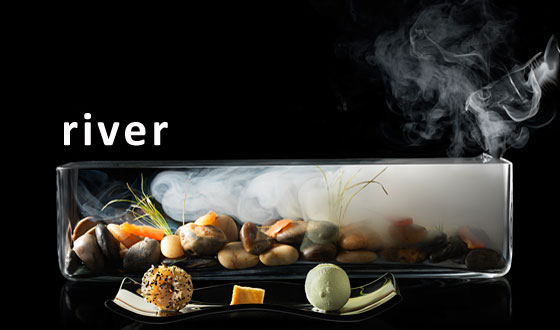
HENSEL: You’re bringing it back from where it came from, but at the same time, you’re taking these ingredients and you’re playing with them. Moto houses high tech equipment that would make any food scientist envious. This lends itself to a lot of experimentation, but you do need a bit of know-how and natural curiosity to figure how these things work. Where did develop this passion for food science and chemistry?
FARINA: Math and science have always kind of been my thing. When I was in school growing up, it always kind of peaked my interest. I really had no intention of pursuing food and science until I saw Homaro on Iron Chef America. It’s kind of the whole idea of—I guess—non-boring food. Not that food on a plate is boring, but I kind of feel that with training anyone that has really great ingredients and splendid plates can make anything look great and taste awesome. I like being able to have the equipment to play around with.
A lot of the stuff that we have in the lab has all been trial and error. We’ve got a manual and we know kind of how to use it, but it’s lots of experimentation. There’s been tons of failure, stuff that doesn’t work. Obviously, you learn from failure. If this didn’t work, why didn’t it?
So, for example, with the rotovap [a rotary evaporator] that we got a year and a half ago, I’d never used one before. I knew what it did, but I had no idea how it worked. We read the manual and did research online. We started doing the juices of vegetables. What does carrot juice taste like? What does this apple juice taste like? What does jalapeno juice taste like? We were trying to take things that we could experiment with, and we found out through all of the testing that the most interesting was the jalapeno.
We would juice it, season it, and give it like a day to get super spicy and fiery. Normally, if you took a spoonful of that liquid it would blow your palate out because of all the capsaicin. Well, once you ran it through the rotovap process and the distillate was collected it actually smelled of green bell pepper and cucumber. And when you tasted it, it was almost like cucumber water. Essentially, we left all of the capsaicin behind in the evaporation flask, and you’re left with a very simple, clean kind of palate cleanser. Being able to have that equipment made that dish. It was one shot of jalapeno juice and a little bit of salt. That was it. The idea behind it was to be able to take people on tours and show them the machine that made it, but also for them to think “Oh, jalapenos are hot, so how is this cool?”
HENSEL: Do you have a favorite piece of equipment in the lab that you really love to use?
FARINA: It’s probably a tie between the rotovap and the freeze dryer. You’re able to really transform the normal state that you’re used to seeing things in. You take a berry and then freeze dry it, and it becomes crispy and tastes even better. So being able to take a piece of already awesome produce and make it better through the use of the equipment is probably the reason why I like that one.
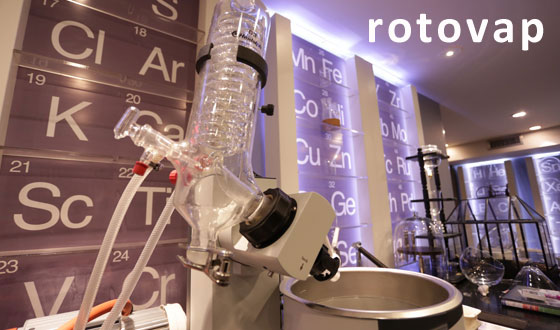
HENSEL: Moto also has an indoor farm in what used to be the staff office. Can you talk a little about the zero food mile effort and how the farm contributes to the menu?
FARINA: Being able to have greens at our fingertips every day makes it super easy. I can talk to the grow room guys, Andrew and Brian, and say, “Hey, I want to use sorrel. Can we get that planted?” “Sure, no problem!” So I know 10 days later, I’ll have the greens that I want to use.
It’s a huge money saver. A lot of the stuff that we get from purveyors costs $15, $20 or $30 for a tiny little clam shell. One plot in our farm can make two to three times that amount. And we’re just paying for the seeds. It’s also about the freshness. I thought for the longest time that a microgreen is a microgreen. If you got it from the best purveyor in the country then it’s going to taste great. But even the stuff that they send out a day later, compared to something that we pick ourselves and eat within 30 seconds of being picked, there is a definite difference in the flavor. Our microgreens just taste much brighter and more flavorful.
We use the microgreens in many dishes, but it is the key item in the first course, which is call the Grow Room. So, we use this glass cylinder that has the greens growing inside of it and a server will drop off some buffalo tartar to the table and this glass cylinder. Then, another server will come by with some tweezers, removes the glass cylinder, and essentially cuts fresh greens in front of you and adds it to the dish. If we just put microgreens on top of tartar and served it to you, it wouldn’t be that cool. But the fact that they’re literally in front of you cutting the greens and then you’re eating them shows that marriage of new technology with old school technique. Seeing the greens cut in front of you actually makes them taste maybe a little fresher because your mind is going, “Those were planted 15 seconds ago, and now I’m eating them.”
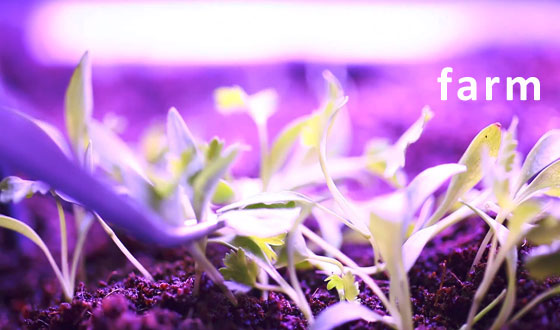
HENSEL: When you have an idea for a new dish for the menu, what is your process for going about creating it?
FARINA: Well, a lot of my inspiration now either comes from a place or maybe I’ll get a single ingredient. One way I’ll develop something now is I’ll walk through Crate and Barrel, Target, or a local garden center and I’ll just pick up random stuff. I’ll find a rock that looks pretty cool and then I’ll go back to the kitchen and think, “Okay, what do I think of when I see a rock? I think of moss growing on top of it, I think maybe there’s some mushrooms.”
Or, another example is when my fiancée and I were driving back from Minnesota last March and we stopped somewhere to eat some food, and I looked over and I saw a maple tree that had a bunch of pretty good size logs that fell off of it. I picked it up and put it in the back of my truck, and when I got back to the restaurant, I walked into my kitchen and said, “We are going to make a plate out of this!” It’s a maple log, what do you think? And one of my chefs said, “Well, maple syrup comes from that!” All right, cool. Let’s make our own maple syrup dispensers! So we cut them down to size. We found a little piece of copper, torched it, and used it to show how you would tap a maple syrup tree. We made our own faux maple syrup dispensers.
So, a lot of my inspiration, now anyways, comes from trying to see the end product presentation. I always start with the presentation of it first and then work backwards through the flavors. I think I’m at a stage where I know what flavors go together. I know what works. It’s more about making the dish interesting and forward thinking and different rather than just like someone else down the street is doing.
HENSEL: Moto is synonymous molecular gastronomy. Do you guys think of yourselves still as that’s what you do, or is it more almost like an Avant-garde art form, but using molecular gastronomy to make those creations come to life. Are you guys defining yourselves as a molecular gastronomy restaurant?
FARINA: Essentially, you just described what I’m trying to do. When I first started at the restaurant, it was strictly, “Okay, we made this encapsulation. Put it on a spoon and serve it to them. It’s cool because it’s an encapsulation.” Now, all the techniques have been discovered, I think, and I’m at a point where we’re kind of trying to do an art form, or trying to change the perception of what it is, but using the molecular techniques as tools.
For example, our wild boar dish is essentially it’s a mole and boar dish but we used the technology of a maltodextrin which absorbs the fat and turns it into a powder. We used that powder as a component. We turned it into the chocolate soil for the landscape of the dish. We used technology to create something that looks like soil to present it in a natural form. Right now a lot of stuff I am doing is taking the “science-y” molecular ends and using them as tools to make the dish look more natural. The goal is to make it look undisturbed, or that not a lot of work went into it. But essentially, 30 steps went into the dish to make it look like nothing happened to it. A lot of complex steps have to go behind it to make it look simple.
HENSEL: Do you have a favorite dish that you’ve made so far?
FARINA: Right now, I’d probably say it’s the mole and boar dish. It’s a dish where I think the flavors really work. But it’s kind of out of my comfort zone. I really don’t deal with a lot of spice, but it has spice mixes and deep earthy flavors that go with it. It’s the exact style that I want to convey of having the dish look like a natural burned landscape after a forest fire happens. We have a green that we grow, and it actually looks like tiny little trees, so we put those coming up from the dishes “soil.” And we have dried mulberries, which when you fry them look like little pine cones. So, it looks like the pine cones after a natural forest fire occurs and they open up and shoot all their seeds everywhere, resulting in the little trees starting to sprout. That’s actually what I created on the dish, but it tastes just like a simple great mole and boar dish.
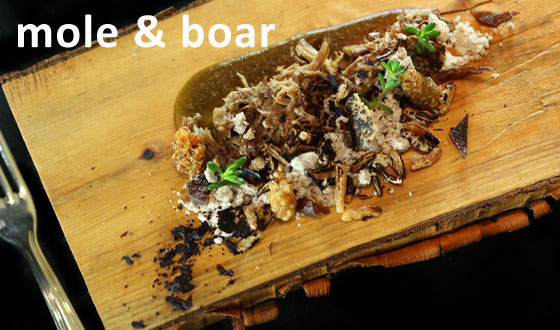
HENSEL: How often do you change out your menu? Is it just kind of dependent on what’s seasonal? What’s inspiring you?
FARINA: Essentially. I call it a rotating seasonal menu. I don’t change all 15 courses at once because it’d be really hard to maintain the quality. So I switch out a dish on the menu every two or three weeks. Sometimes, if I get really inspired and I have a bunch of ideas, I’ll do two within two weeks, but it’s always at least one new dish going on the menu every two or three weeks.
It keeps me busy and it keeps my cooks happy. They see a bunch of new dishes coming through and they learn a lot more that way, as opposed to seeing the same thing for six months straight. You’re not concentrating as much as maybe you do when you first learn a dish. You get into a routine. With new dishes, you’re probably going to be more on your toes. I also tend to have more longevity with my employees, and I think this is part of the reason why. Passing down new dishes and techniques to my cooks, means they don’t get bored. You create a fun atmosphere for them by having the dishes change all the time.
HENSEL: Moto is celebrating is 10-year anniversary. As the Executive Chef, do you have a far reaching goal of where you want to take the restaurant in the next 10 years?
FARINA: Well, I would love to get two [Michelin] stars, and maybe eventually get a third star. I think, though, it all comes down to overall experience to get the accolades and all that. My goal would be to get the restaurant the credit I think it deserves. Despite the TV and all of the publicity we’ve done over the last eight years, I think that people still kind of see it as—for lack of a better term—the gimmicky place that does weird stuff. And I want to legitimize what we do as really awesome tasting food that is presented differently. Just because you haven’t seen it that way doesn’t mean that’s bad or weird. It’s just a different experience. Homaro’s worked so hard in the last 10 years to get the restaurant where it is, and my main goal would be to carry that on and elevate it even more than he could. Essentially, bring it the credit that it deserves.
I think the whole molecular gastronomy thing got a bad rap for a while. It was a fad and everyone was trying to do it, and the ones that did it badly kind of ruined it for the rest of us. The ones that did it well and made it work are still around. There were so many people that had all these ingredients and equipment that became available. They even sell molecular gastronomy kits now where you can do stuff at home. But people forgot that you have to make the food taste good before you gel it or freeze it. You can make a encapsulation of carrots and make it look like an egg yolk, but you just can’t take carrot juice and add calcium alginate to it and make an encapsulation and expect it to be awesome. You have to have the original product taste good before you mess with it. So for a lot of people, I think molecular gastronomy got a bad rap. I think it actually maybe hurt some restaurants that were doing it well.
HENSEL: I read that when you were in culinary school, you helped the school win three ice carving championships. Is that right?
FARINA: I did. When I went away to school, I always felt differently than all the other kids. When everybody else was going out and partying, I would stay back in my dorm and watch TV and read. I ended up talking to my mom and she said, “Why don’t you look and see what’s going on?” And I happened to see an ad for ice carving, and I said, “Oh, that sounds fun! Let me try that out.” I went to one club meeting, and I think I carved a fish next to seaweed or something, and the instructor that was running it I guess saw the raw talent in me and was like, “Hey, would you be interested in being part of the team and doing stuff for me?” So I ended up working for him for three years, and while you do that, you’re on the team. I had two different partners over three years. We took first place in the national collegiate competition three years in a row.
HENSEL: Did you do art as a kid? Were you drawing and painting and doing all that kind of stuff?
FARINA: I mean, I’ve always been artsy and creative at least a little bit. I was involved in drama in high school. I’ve always sort of gravitated towards the arts. It’s funny because I can’t draw at all. But for some reason, give me a chainsaw and a chisel and I can make pretty much what I want.
HENSEL: You are engaged, congrats. How does an Executive Chef at a Michelin starred restaurant plan a wedding menu?
FARINA: Well, we got kind of lucky. The venue we picked—the Patrick Haley mansion—you have to use their catering, so I was a little worried at first because we saw the pictures of the food, and it did not look all that appetizing. But we did a tasting back in October, and surprisingly, a lot of the food tasted better than I thought it was going to. We kind of picked the two best dishes and we’ll leave it in their hands. We’ll have a little salt and pepper shaker on the table for a little extra seasoning here and there, but for that day, so long as it tastes okay, we’re all right with that. You don’t want to be a chef and have bad food at the wedding.
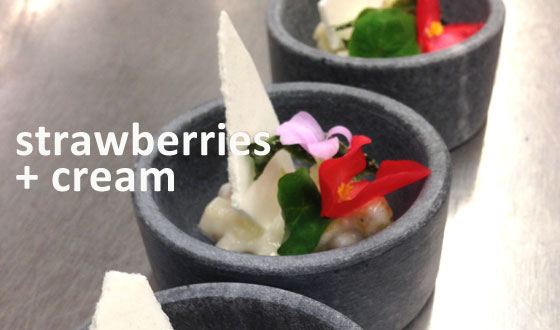
Richie's Recipe: Strawberries & Cream (currently on the menu at Moto)
Milk Crisp
250 g skim milk
1.5 g iota carrageenan
75 g sugar
25 g milk powder
1 g salt
- Heat skim milk in a small saucepan.
- Blend with iota carrageenan for 1 min.
- Place milk mixture in a blender. Add sugar, milk powder, and salt.
- Place mixed milk in a mixer with a whisk attachment and mix on high speed until cooled and doubled in volume.
- Spread on a Silpat (silicone baking mat) about 1/4 inch thick.
- Dehydrate 140°F until crispy.
- Store in dehydrator at 90°F
Ricotta cheese
½ gal whole milk
1 cup heavy cream
¼ cup distiller white vinegar
1 tbsp salt
10 g Ultra-Tex 8 (tapioca starch)
200 g whey
- Place salt, milk, and cream in a medium sauce pot over low to medium heat.
- Bring milk mixture up to 180°F.
- Once milk is up to temperature, remove from heat and transfer milk to a container.
- Add vinegar to milk mixture and wisk for 10 sec (this starts to break up the curds) and ensures vinegar is fully mixed in.
- Cover container with plastic wrap and let sit out at room temperature for 2 hrs.
- After 2 hrs, place a sieve lined with cheese cloth over a large container.
- Strain cheese through strainer.
- Cover with plastic wrap and place in refrigerator for 24 hrs to let all the whey strain from cheese.
- Reserve cheese .
- Mix 200 g of whey with 10 g of Ultra-Tex 8 (tapioca starch). Blend for 1 min with hand blender.
- Re-season with salt.
- Keep thickened whey to mix with green strawberries.
10 green strawberries
3 dehydrated cucumber skins
2 flowers (oxails, sorrel)
1 nasturtium greens
Thickened whey from making the ricotta
- Cut the strawberries into 16 pieces equal in size.
- Take 1 tbsp of whey and mix with 2 strawberries.
- Place a small amount of whey and berries in the bottom of a bowl.
- Garnish with milk crisp, cucumber skins, flower, and greens.


